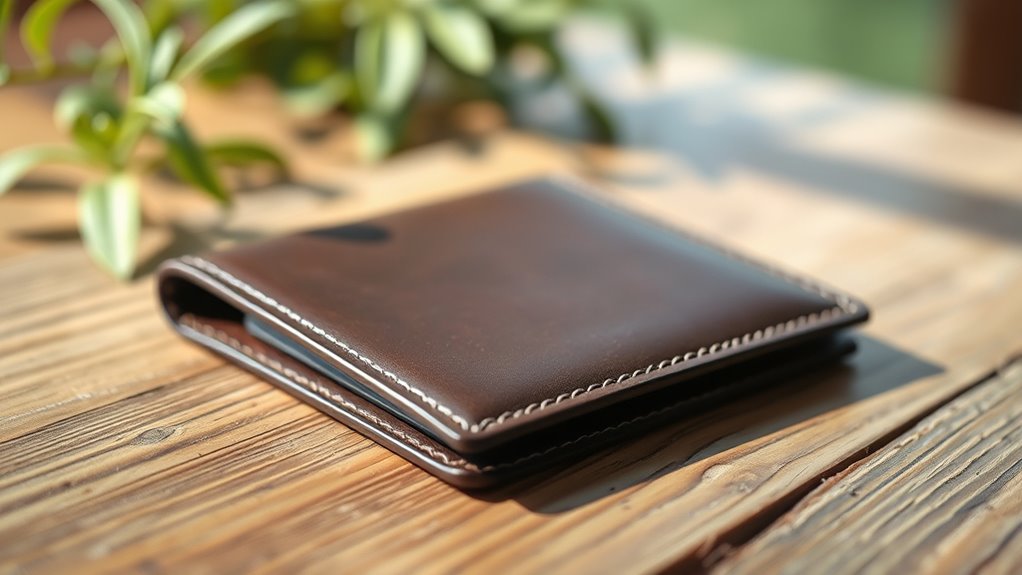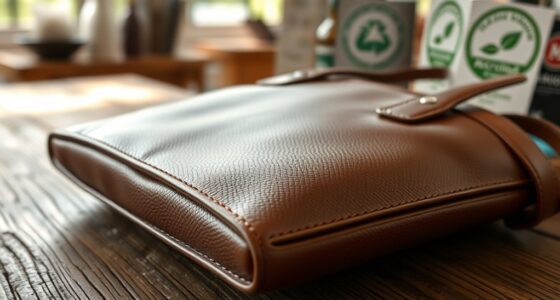Vegan leather wallets are eco-friendlier than traditional leather, as they use less water, land, and emit fewer greenhouse gases. However, their production can involve chemicals that might pollute water and soil, and they shed microplastics that harm marine life. While sustainable materials and eco-friendly practices are improving, some environmental concerns remain. Understanding these pros and cons can help you make better choices—if you want to learn more, keep exploring these factors in detail.
Key Takeaways
- Vegan leather wallets generally produce fewer greenhouse gases and require less water than traditional leather.
- Manufacturing involves chemicals that can pollute water and soil if not managed properly.
- Recycling and disposal pose challenges, with some vegan leathers shedding microplastics and impacting marine environments.
- Using sustainable materials and eco-friendly processes can reduce environmental impact and resource depletion.
- Choosing transparent, certified brands promotes environmentally responsible production and ethical labor practices.
The Manufacturing Process of Vegan Leather Wallets

The manufacturing process of vegan leather wallets involves transforming sustainable materials into durable, stylish accessories. You start with synthetic materials, like polyurethane or plant-based leathers, which are designed to mimic traditional leather’s look and feel. Producing these synthetic materials typically results in manufacturing emissions, mainly from energy-intensive processes and chemical use. These emissions contribute to the wallet’s overall carbon footprint, but they often remain lower than those from conventional leather production. During manufacturing, the materials are cut, stitched, and treated with dyes or finishes to achieve the desired appearance. While synthetic materials eliminate animal cruelty concerns, their production still impacts the environment through emissions. Advances in eco-friendly manufacturing technologies aim to reduce emissions further and promote more sustainable practices. Additionally, the development of sustainable materials is helping to lessen the environmental burden of producing vegan leather. Moreover, efforts to improve recycling and disposal methods can help mitigate environmental impacts at the end of the product’s life. Exploring renewable energy sources during manufacturing can also significantly lower the carbon footprint of vegan leather production.
Environmental Benefits of Choosing Vegan Leather

Choosing vegan leather wallets can substantially reduce your environmental impact because they require fewer resources and emit fewer greenhouse gases than traditional leather. By opting for vegan options, you support sustainable sourcing practices that avoid habitat destruction and reduce water consumption. This shift also encourages the adoption of high-quality equipment, which can lead to more efficient and eco-friendly production processes. Implementing sustainable manufacturing methods further enhances the environmental benefits of vegan leather. Additionally, vegan leather production often involves less chemical usage, which minimizes pollution and reduces health hazards for workers. For example, innovations in eco-friendly tanning techniques have made plant-based and water-based processes more viable and less harmful. The development of biodegradable materials in vegan leather also helps reduce waste and environmental persistence. This choice also helps lower your carbon footprint through: 1. Fewer greenhouse gases released during production, cutting down on air pollution. 2. Reduced reliance on livestock farming, which is a major contributor to methane emissions. 3. Less water usage compared to conventional leather manufacturing, conserving essential water resources. These benefits collectively make vegan leather a more eco-friendly option, aligning your purchase with environmentally conscious values. By choosing vegan wallets, you contribute to a more sustainable future and lessen the environmental toll associated with traditional leather.
Potential Environmental Drawbacks and Concerns
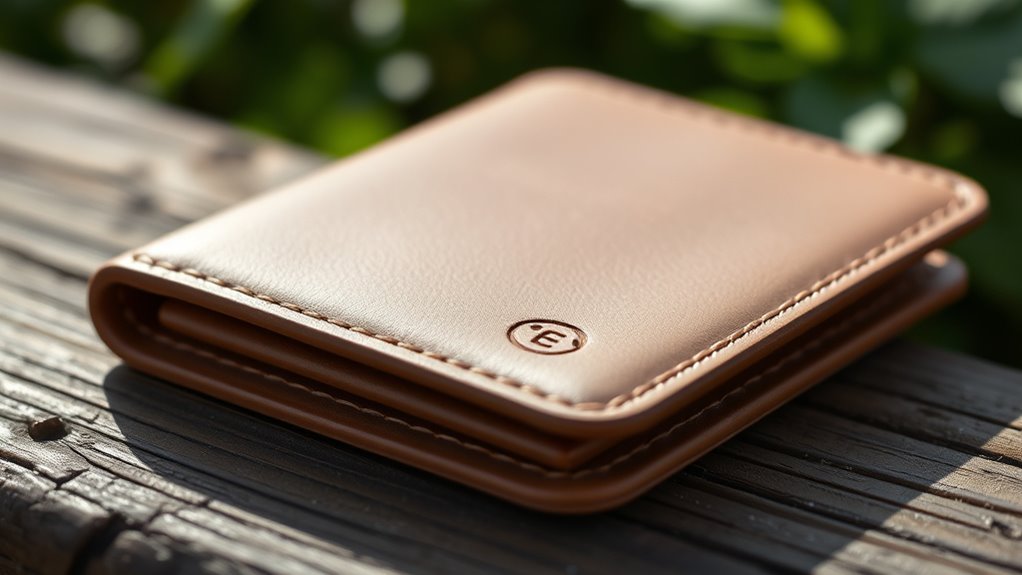
Although vegan leather offers notable environmental benefits, it also presents certain drawbacks that warrant consideration. One concern is chemical pollution, as producing many vegan leather types involves chemicals that can contaminate water and soil if not managed properly. These chemicals may pose risks to ecosystems and human health over time. Additionally, resource depletion is a significant issue; manufacturing vegan leather often requires substantial amounts of water, energy, and raw materials like plastics or synthetic fibers. This can lead to the exhaustion of natural resources, especially if production isn’t sustainable. While vegan leather reduces reliance on animal agriculture, it’s important to recognize that its environmental footprint isn’t entirely free of negatives. Being aware of these drawbacks helps you make more informed, environmentally conscious choices. Furthermore, the energy consumption associated with manufacturing vegan leather can be quite high, contributing to carbon emissions and climate change if not managed sustainably. It is also vital to consider the recycling and disposal challenges that synthetic vegan leathers pose at the end of their lifecycle, which can impact waste management systems. Additionally, some vegan leather products may contain microplastics that shed during use and disposal, potentially contaminating water sources and harming marine life.
Comparing Vegan Leather to Traditional Leather
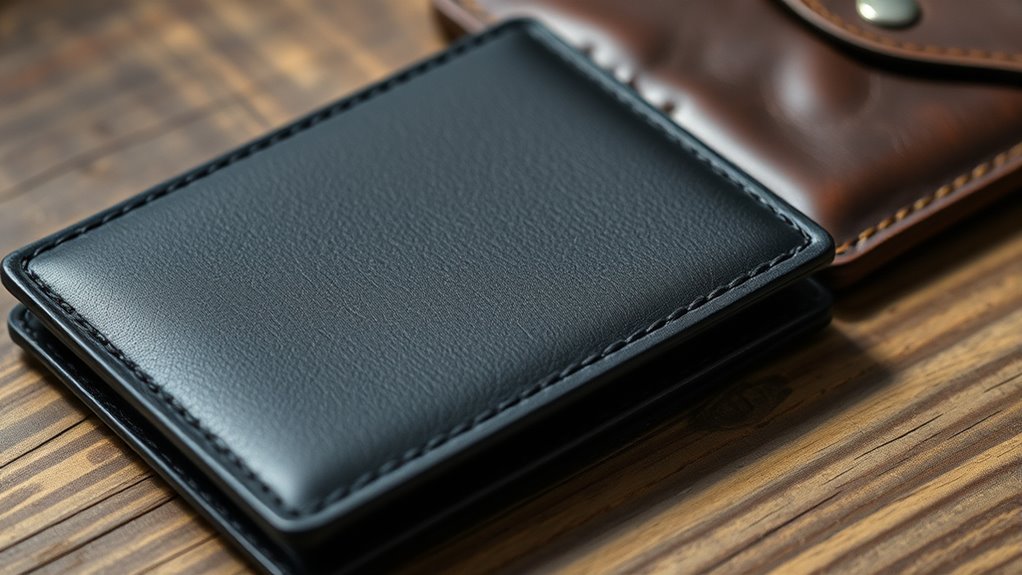
How does vegan leather compare to traditional leather regarding environmental impact and durability? Vegan leather, made from synthetic alternatives, often requires less water and land, reducing ecological strain. It avoids animal cruelty, providing a cruelty-free option. Imagine:
- A sleek wallet made from synthetic fabrics, saving animals from suffering.
- A surface that resists scratches and stains, mimicking genuine leather’s durability.
- A product that’s lightweight yet sturdy, perfect for daily use.
- Advances in materials technology are helping vegan leathers become more durable over time, and ongoing research into eco-friendly production methods aims to further reduce environmental impacts. Additionally, sustainable manufacturing practices are increasingly being adopted to minimize waste and energy consumption in the production process. These innovations are contributing to a more environmentally friendly fashion industry by promoting responsible sourcing and production.
Tips for Choosing Eco-Friendly Vegan Leather Wallets
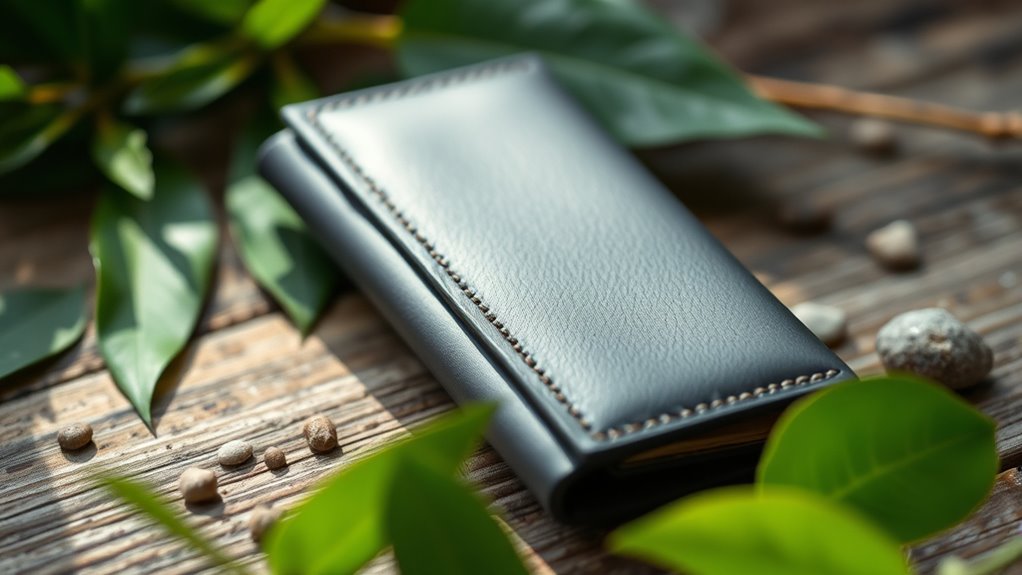
To find eco-friendly vegan leather wallets, focus on brands that prioritize sustainable sourcing and transparent manufacturing practices. Look for labels that openly share details about their supply chains, ensuring they use environmentally conscious materials. Prioritize companies that emphasize ethical labor practices, so workers are paid fairly and work in safe conditions. Check for certifications or eco-labels that verify sustainable efforts, such as low-impact dyes or recycled materials. Avoid brands that lack transparency or rely heavily on synthetic chemicals, which can harm the environment. Incorporating sustainable materials can also help you make more mindful choices when selecting accessories, ensuring they align with your values. Being aware of product lifecycle considerations can help you choose wallets that are built to last and have a reduced environmental footprint. Additionally, understanding wall organization systems can help keep your accessories organized and in good condition, prolonging their lifespan. Utilizing eco-conscious design principles can further enhance your ability to select environmentally friendly products. This way, you make a positive impact on the planet while enjoying a stylish, cruelty-free accessory.
Frequently Asked Questions
How Long Do Vegan Leather Wallets Typically Last?
Vegan leather wallets usually last between one to three years, depending on usage and quality. Durability concerns can arise with cheaper options, but with proper maintenance tips like cleaning gently and avoiding excessive moisture, you can prolong their lifespan. Investing in high-quality vegan leather wallets ensures better durability, making them a practical, eco-friendly choice. Regular care helps prevent cracks and fading, so your wallet stays looking good longer.
Are Vegan Leather Wallets More Affordable Than Traditional Leather?
Think of the classic tale of the tortoise and the hare—you might expect vegan leather wallets to be cheaper, but the truth is nuanced. The price difference often hinges on material costs; vegan alternatives can be more affordable due to cheaper production, but high-quality options may match or exceed traditional leather prices. Ultimately, your choice depends on your budget and values, balancing cost with eco-consciousness.
Can Vegan Leather Be Recycled or Composted?
You might wonder if vegan leather can be recycled or composted. While some recycling options exist, they’re limited because vegan leather often contains plastics that complicate recycling. Compostability challenges also arise since many vegan leathers aren’t biodegradable and contain chemical treatments. So, though it’s sometimes recyclable, you should check specific product labels and care instructions to understand the best disposal method for your vegan leather wallet.
What Brands Offer the Most Sustainable Vegan Leather Wallets?
Think of finding a truly sustainable vegan leather wallet as discovering a hidden oasis. Brands like Matt & Nat, Stella McCartney, and Veja lead the way, prioritizing sustainable sourcing and ethical manufacturing. They craft wallets that not only look good but also honor the planet. By choosing these brands, you support a future where style and sustainability walk hand in hand, making your everyday choice a powerful act of kindness to Earth.
Do Vegan Leather Wallets Contain Any Harmful Chemicals?
You might wonder if vegan leather wallets contain harmful chemicals. The chemical composition varies depending on the manufacturing process, but some alternatives use plastics or synthetic materials that may include chemicals like phthalates or formaldehyde. However, many brands now prioritize safer, eco-friendly options, reducing or eliminating harmful substances. Always check product details or certifications to guarantee your wallet’s chemical makeup aligns with your health and environmental values.
Conclusion
Choosing a vegan leather wallet might just save the planet from an environmental apocalypse! By making the switch, you’re dodging the destructive practices of traditional leather and embracing a future where your wallet’s impact is almost non-existent. It’s like wielding a superhero shield against pollution and animal harm. So go ahead, pick an eco-friendly vegan leather wallet — your small choice could spark a global revolution and turn you into an unstoppable eco-warrior!
